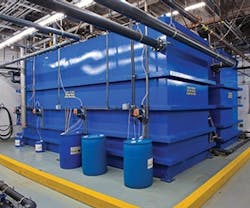At over a million square feet and approximately 700,000 visitors annually, the Vancouver Convention Centre (VCC) is no stranger to waste management. With a membrane bioreactor treating 100% of collected sewage, water efficiency is a central tenet of this LEED Platinum facility.
Processing an average of 45,000 gallons a day (or 6,000 cubic feet), the 1,200-square-foot treatment plant is located in the Centre’s West building, notes Mike Garcia, senior manager of VCC’s facility operations and engineering. Black and greywater are collected at two lift stations on either side of the centre. Depending on the volume, waste is either pumped to the city sewer or an equalization tank adjacent to the treatment plant.
Two grinder pumps draw the water from the 10,000-gallon holding tank to the aeration tanks, where bacteria break down the solids. The liquid sewage then flows into the membrane bioreactor. Water is extracted by use of a vacuum induced on the filter and effluent is separated. Chlorine is injected into the effluent before going into a touch tank that removes any turbidity.
The treated water then goes to two 10,000-gallon storage tanks. Pumps move the treated water back into the building for toilet flushing and irrigation needs, most notably on the centre’s hallmark six-acre green roof.
The waste treatment plant is staffed by a full-time operator. Daily labs are drawn for water quality and samples are sent out twice a week for third-party testing. A consulting firm is responsible for collecting the reports and submitting them to the Ministry of Environment, a Canadian federal agency.
While the plant has experienced little downtime over the years, the biggest challenge has been adjusting to the centre’s peak and slow times. To keep the bacteria levels consistent during the off season, dog food is used to act as supplemental sewage. It’s an unusual maintenance request, but it keeps the system running smoothly regardless of restroom traffic.
While the membrane bioreactor offers significant water savings, it works in conjunction with several other efficiency features to maximize conservation. The building also uses low-flow toilets and faucets, grease interceptors, and a 72-zone drip irrigation system that has 15 moisture detectors for its living roof.
A reverse osmosis plant also desalinates seawater, which supplements the MBR output during peak irrigation season. These strategies were fundamental to securing a number of LEED credits for the project.
While the investments were part of a bigger sustainability package, the savings are obvious – close to 74 million gallons of water reclaimed since 2008.
“There’s a lot of interest in adopting this technology at other properties,” says Garcia. “Out of all of the convention centre’s green features, the sewage treatment plant is by far the most toured part of the building by industry colleagues.”
About the Author
Jennie Morton
A former BUILDINGS editor, Jennie Morton is a freelance writer specializing in commercial architecture, IoT and proptech.
